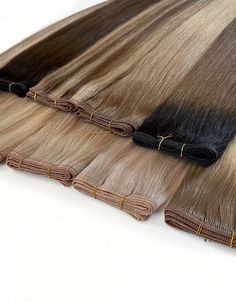How to Color Match Hair Extensions
A proper color match for hair extensions ensures that your extensions blend flawlessly with your natural hair. Mismatched tones can be very noticeable, especially in natural light or when styling your hair. Whether you wear clip-ins, tape-ins, or wefts, the goal is always the same: to achieve a smooth, invisible transition from your hair to the extensions.
Understanding Hair Color Basics
Hair color is more complex than it appears. Most people have multiple tones in their hair, including base colors, highlights, and undertones. To Color Match Hair Extensions successfully, you need to consider more than just one shade.
Professional colorists use a level system from 1 to 10, where 1 represents the darkest black and 10 indicates the lightest blonde. However, successful color matching goes beyond this basic numbering system. Your hair also contains warm, cool, or neutral undertones that significantly impact how colors appear when placed side by side.

| Component | Explanation |
|---|---|
| Base Color | The dominant shade you see overall |
| Undertone | Warm, cool, or neutral tones that affect how the color looks in different light |
| Highlights/Lowlights | Lighter or darker strands that add depth and dimension |
The Natural Lighting Test Method
Artificial lighting can dramatically distort hair colors, making accurate matching nearly impossible indoors. The most reliable approach to Color Match Hair Extensions involves testing potential colors in natural daylight, preferably during midday when lighting is most
Step outside or position yourself near a large window with direct sunlight. Take a small section of hair from the area where you plan to clip your extensions. Hold this section against your potential extension colors, observing how they blend together in natural light conditions.
Move around slightly to see how the colors interact in different angles of natural light. Take photos during this process to compare different shades later. Natural lighting reveals subtle color differences that indoor lighting often conceals, helping you identify the most compatible match for your specific hair color.
- Go outside or near a large window during midday.
- Take a clean section of your mid-length hair.
- Hold it against different extension shades.
- Check from multiple angles and take photos.
- Choose the shade that blends best in sunlight.
Focus on the Mid-Lengths and Ends
Many people make the mistake of matching extensions to their root color, but this approach rarely produces natural-looking results. Instead, focus on matching the mid-lengths and ends of your hair, where extensions will actually blend and create the most visual impact.
The middle and lower sections of your hair often differ significantly from your roots due to sun exposure, previous coloring, and natural fade patterns. These areas typically appear lighter and may have different undertones than your root color. When you Color Match Hair Extensions to these sections, the blending appears more seamless and natural.
Pay special attention to the areas around your face and shoulders, where your extensions will be most visible. These sections often receive the most sun exposure and may have lighter, more varied tones that require careful matching consideration.
Consider Undertones
Undertones play a crucial role in successful color matching and can make or break your final result. Cool undertones include ash, silver, and violet hues, while warm undertones feature golden, copper, and red elements. Neutral undertones contain balanced mixtures of both warm and cool elements.
Identifying your hair’s undertones requires careful observation in natural light. Look for subtle color hints that become apparent when comparing your hair to pure white or neutral backgrounds. Cool-toned hair often appears slightly ashy or silvery, while warm-toned hair shows golden or reddish hints.
When selecting extensions, ensure the undertones match your natural hair’s undertone family. Even if the base color appears similar, mismatched undertones will create an obvious contrast that makes extensions look artificial and poorly blended.
One of the most overlooked tips in how to color match hair extensions is undertones. Ask yourself:
- Does your hair reflect golden or warm tones?
- Does it have ashy or cool tones?
- Or is it a neutral shade?
| Hair Tone | Undertone Example | Recommended Extension Shade |
|---|---|---|
| Warm | Golden Blonde, Auburn | Honey Blonde, Chestnut Brown |
| Cool | Ash Blonde, Jet Black | Platinum Blonde, Ash Brown |
| Neutral | Natural Black, Beige Blonde | Neutral Black, Dirty Blonde |
Key Factors to Consider When You Color Match Hair Extensions
| Factor | What to Look For |
|---|---|
| Lighting | Always check your hair color in natural daylight—not under artificial lighting. |
| Hair Section to Match | Focus on the mid-lengths to ends, not the roots. |
| Undertone | Identify if your hair is warm, cool, or neutral. |
| Texture | Choose extensions that match the texture of your natural hair. |
| Blending Techniques | Use layering, styling, or toning to help with final blending if the shade isn’t exact. |
Ask for Professional Help
While DIY color matching is possible with patience and practice, professional assistance often delivers superior results. Hair professionals understand how lighting, texture, and styling affect color perception and can provide expert guidance for challenging matches.
Still don’t know how to color match?
For personalized color matching assistance, contact Fshine online or send Fshine an email to access their professional color matching service.we’ll respond within 24 hours.